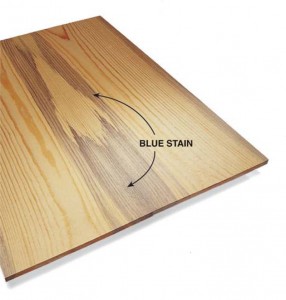We may receive a commission when you use our affiliate links. However, this does not impact our recommendations.
I have some pine that was given to me. The price was right but the wood is full of blue stain. Is it safe to use this wood for painted projects or as a secondary wood?
A:
Blue stain is a common fungus that infects the sapwood of freshly sawn boards causing a blue discoloration in pine. The infestation most often occurs during the summer months when freshly sawn boards are exposed to the open air before kiln drying. The color can range from a striking blue to a dull gray or black. We asked Harlan Petersen at the University of Minnesota Department of Wood and Paper Science about blue stain.
Mr. Petersen told us that blue stain is a non-destructive fungus that has little or no effect on the structural integrity of the wood, so it is safe to use in terms of strength. However, because more destructive organisms thrive under the same conditions that lead to blue stain, it is advisable to inspect your boards for weakened wood fibers or punkiness.
The Western Wood Products Association encourages woodworkers not to think of blue stained pine as junk wood. Often your blue stained boards can be used like a spalted or figured wood to create dramatic effects (see photo).
Here are some supplies and tools we find essential in our everyday work around the shop. We may receive a commission from sales referred by our links; however, we have carefully selected these products for their usefulness and quality.










Blue stain is often associated with trees that are killed by the pine bark beetle. It can make some interesting wood, and the beetle infestation is long gone when the tree dies. Whole forests out west have been killed by this small insect.
By stopping all forest fires and prohibiting spraying, nature has found a way to kill even greater amounts of trees. Unintended environmental consequences of doing what feels good instead of sound scientific procedures.